Settlements > Babylon
Babylon
Background
The ancient city of Babylon was the capital of the civilization of Babylonia and can be considered the heart of the Mesopotamian culture. While there were other grand cities and settlements throughout the ancient Middle East, none compare to the prestige and power granted to Babylon.
The ancient city of Babylon was renknowned around the world for featuring magnificent Structures such as the Hanging Gardens of Babylon, the Ishtar Gate, the Esaggila, also known as the biblical Tower of Babel.
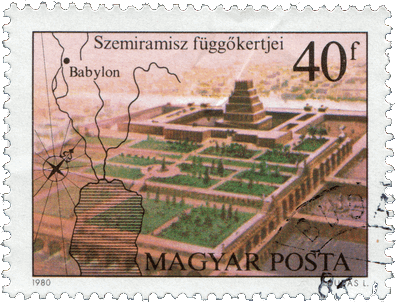
Babylon Stamp - 1980's
The greatest point for knowledge, culture and human achievement in the ancient world, Babylon is discussed deeply in the Bible and other religious materials and by ancient historians. Despite its massive significance in the story of man, current archaeological excavation of the city is impossible and as of this current writing countless Assyrian cities have been razed to the ground by the new caliphate calling itself the Islamic State.
It is a sad point for history however, this does not deter real researchers from finding the truth. Back when the Middle East was not a modern day Call of Duty map, many European explorers and archaeologists excavated what they could of Babylon and much of what we know about the city is because of their efforts.
Babylon's history is as long as time itself. Rising out of the desert during the Neolithic Revolution, Babylon was one of the key cultural centers all the way through Alexander the Great and the Romans.
Babylon is noted for developing in the fertile crescent between the Tigris and the Euphrates river in modern day Iraq known as Mesopotamia. The city as it was famously known was built in equal parts along the banks of the Euphrates river and had massive embankments that would help contain the yearly floods.
While Babylon existed in grandeur for many millennium eventually however, like all Settlements and civilizations Babylon was abandoned soon slipped underneath the sands of the desert.
Old Babylon
The original city of Old Babylon was founded around 2500 BC right at the point where the Tigris and Euphrates Rivers converge. According to some sources it was founded by Sargon of Akkad, also known as Sargon the Great of the Akkadian Empire however other sources claim the settlement was established before him.
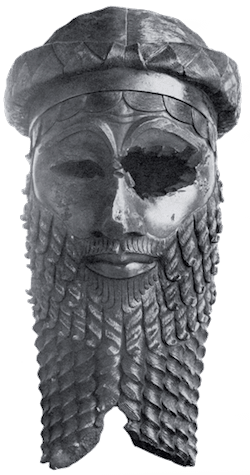
Sargon the Great Bronze Head
Babylon was possibly an older settlement that was simply conquered by Sargon and assimilated into his empire. Due to its strategic location it simply became the dominant city state in the region and grew its power over time.
It is hard to determine where exactly Old Babylon was because the rivers have risen and fallen along with changing course over many millennium. Regardless, Sargon the Great who ruled from 2334 to 2279 BC built great temples at the city of Babylon and at this time it was just a fledgling port town in the larger area of Mesopotamia.
Hammurabi & Babylonia
The next time Babylon appears in history is when an Amorite prince named Hammurabi was made king of Babylon after his father Sin-Muballit abdicated his throne. Hammurabi is one of the most famous leaders of ancient Babylon, known for codifying laws and creating one of the first justice systems.
Due to his initiatives in justice and governmental policies he built Babylon up to great heights never seen before in the Mesopotamian region. He also initiated massive public works projects such as improving the walls of the city and building great temples and canals. Hammurabi was a brilliant military strategist as well as a diplomat. Through his efforts he was able to bring all of the disparate tribes of Mesopotamia all under control of Babylon, creating the new realm of Babylonia.
Millennium of Turmoil
Like most ancient leaders, once Hammurabi died the empire began to experience a period of decline until 1595 BE when it was raided and conquered by competing neighboring groups for nearly a thousand years. First Babylon was conquered by a group called the Hittites. The Hittites were in turned sacked by the Kassites and the city was renamed Karanduniash. Next, the Assyrians took the city from the Kassites under the rule of King Sennacherib (705-681 BC).
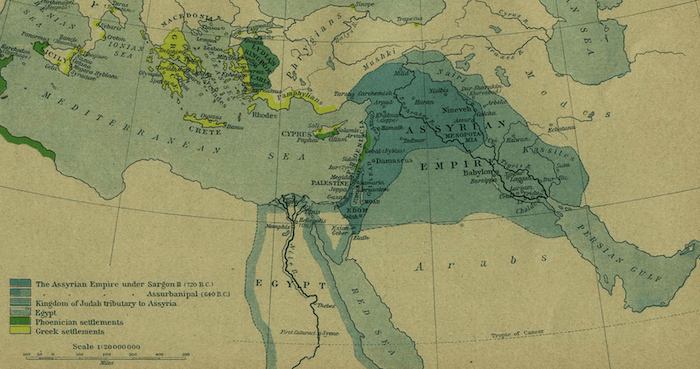
Assyrian Empire Map (750-625 BC) - Historical Atlas (1923)
However, the people of Babylon were sick of foreign rule and under Sennacherib they revolted. After having to forcefully put down the rebellion, the Assyrian king order the complete destruction of Babylon and the ruins scattered in the desert. This spelled the end for the ruler as his drastic policies were deemed heinous by his ruling elite and he was assassinated by his sons in a coup.

King Sennacherib - Nineveh Palace Relief
Babylon held special religious significance to the people of Mesopotamia and to destroy it in such a manner was believed to have greatly offended the gods. So in the wake of its utter decimation, Babylon was rebuilt to its former glory under the Assyrian king Esarhaddon who successfully ruled over it, passing leadership down to his son Ashurbanipal.
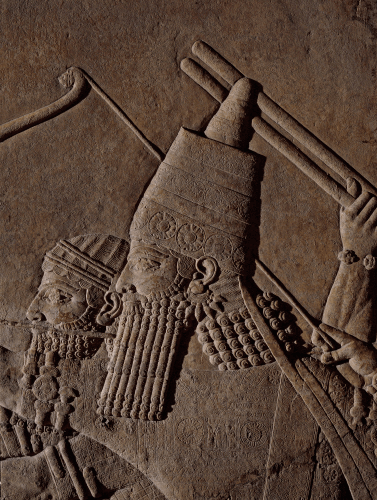
Ashurbanipal - Babylonian Relief
At this point the city of Babylon was known around the world as a center of commerce and knowledge. It was beginning to develop more into the Babylon of popular culture with great canals, gardens and public works projects.
If you want to learn more about the Hanging Gardens of Babylon, click here.
Death of Ashurbanipal
When the Assyrian King Ashurbanipal died in 627 BC there was a period of political instability led to fragmentation within the empire. When the Assyrian centralized authority collapsed over the vassal states they simply asserted themselves as the dominant power in their respective region.
Neo-Babylonia
The power vacuum created by the death of the Assyrian king created the prime conditions for a revolution. The leader of this revolution was a Chaldean named Nabopolassar who in 616 BC took over leadership of Babylon and declared its independence from Assyria and Nineveh.

Babylon - Frantisek Kupka (1906)
Ashurbanipal had passed authority to his much weaker son Ashur-etil-ilani who was going to have nothing of a Babylonian revolution. However, Nabopolassar began creating diplomatic and military alliances with the Medes, Persians, Scythians, and Cimmerians.
The Assyrians were backed by the Egyptians however, despite this they were able to make great victories such as Nippur in 615 BC. Suffering military defeats and territorial losses coupled with ineffective leadership, the political situation in Assyria was rife with internal conflict.
Siege of Nineveh
In 612 BC Nabopolassar led a siege of Nineveh and was able to conquer the city. It was utterly destroyed most likely in revenge for what the Assyrians did to the Babylonians before. This effectively meant the end of the Assyrian Empire.
The Assyrians that survived the assault on Nineveh fled to neighboring Harran in modern day Syria. Their new king was a man named Ashur-uballit II who was a member of the Assyrian royal family and a general in the army.
There may have been quite a few changes of leadership as many were killed during the battle of Nineveh as it is known he inherited the position from his brother Sin-shar-ishkun who indeed died there.
At Harran, Ashur-uballit II regrouped all his forces and attempted to defend from the incoming Babylonian onslaught. Between 611 and 610 BC Nabopolassar led his New-Babylonia army and conquered the city of Harran and its surrounding territory.
Egyptians
In response to the encroaching Babylonians, the Egyptians decided to form a military alliance with the last remnants of the Assyrian army and attempt to stop their advance before it reached Egypt's doorstep.
In the spring of 609 BC, Pharaoh Necho II of Egypt marshaled a mercenary army to assist the Assyrians in their battle with Babylon. Following a path along the Mediterranean assisted by the Egyptian navy. Following the coastal Via Maris into Syria, they eventually had to pass through the Kingdom of Judah.
King Josiah had already sided with the Babylonians and attempted to halt the advance of the Egyptian army at this point. Josiah was killed in the following Megiddo battle and Ashur-uballit was able to join his forces with the Egyptian mercenary army.
With this combined force they led a counter-siege against Harran however, they failed to capture the city and retreated into northern Syria. It was going to be here there was a final showdown for supremacy over the Middle East region.
Battle of Carchemish
In 605 BC a decisive battle was fought for control over the ancient Middle East region. Called the Battle of Carchemish, it was fought between the Babylonians and their allies and the Egyptians and the last remnants of the Assyrian army.
Led by Nabopolassar's son, Nebuchadnezzar II was able to defeat this combined Egyptian and Assyrian force and he soon conquered all of Syria and Phoenicia. Thus, Nabopolassar was finally able to realize his dream of a unified Babylonia.
Nebuchadnezzar II
The city itself was expanded and there was a massive stone bridge built that connected both halves of the city over the Euphrates River.The bridge across the Euphrates is of particular interest, in that it was supported on asphalt covered brick piers that were streamlined to reduce the upstream resistance to flow, and the downstream turbulence that would otherwise undermine the foundations. Nebuchadnezzar's construction activity was not confined to the capital; he is credited with the restoration of the Lake of Sippar, the opening of a port on the Persian Gulf, and the building of the Mede wall between the Tigris and the Euphrates to protect the country against incursions from the north. These undertakings required a considerable number of laborers; an inscription at the great temple of Marduk suggests that the labouring force used for his public works was most likely made up of captives brought from various parts of western Asia.
There was also an underground passage that connected the two parts of the city.
While he was away fighting in Syria, King Nabopolassar fell ill and abdicated his throne in 605 BC. Nebuchadnezzar II rushed home to secure the dynasty and his right to leadership over the empire. Within months of passing the crown to his son, Nabopolassar was dead of natural causes at about 53 years old
Nebuchadnezzar had the same vision of a unified Babylonia empire as his father and began a massive system of public works projects that placed Babylon literally on the map. He renovated and updated the city along with building massive ziggurats and temples.
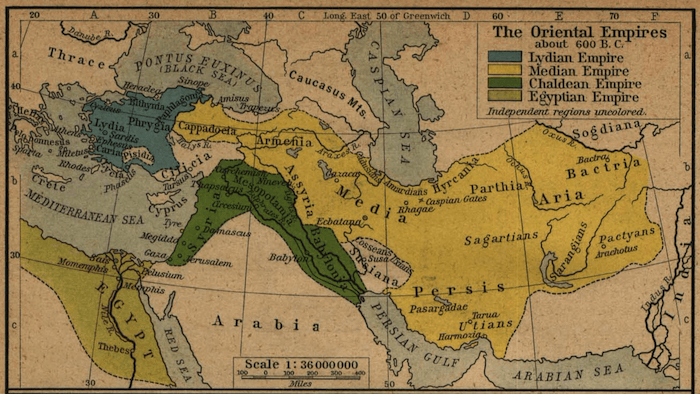
Mesopotamian Empires 600 BC - Historical Atlas (1923)
Under Nebuchadnezzar II the city of Babylon grew to about 900 hectares or around 2,200 acres and some of the most iconic structures were built during this time. The city was written about by nearly every ancient writer, including the famous Greek historian Herodotus.
While Herodotus is rumored to have never visited Babylon, he writes this about the city.
The city stands on a broad plain, and is an exact square, a hundred and twenty stadia in length each way, so that the entire circuit is four hundred and eighty stadia. While such is its size, in magnificence there is no other city that approaches to it. It is surrounded, in the first place, by a broad and deep moat, full of water, behind which rises a wall fifty royal cubits in width and two hundred in height.
Under the rule of Nebuchadnezzar the city developed on both sides of the Euphrates river which was contained with massive mud walls lined with an ancient form of asphalt to keep the water out. An underground passage and a massive stone bridge connected the two halves of the city.

Ruins of Babylon - 1905 Map
Human Rights
Under Nebuchadnezzar human rights advanced greatly, especially for women. While not considered equal by modern standards, women had much more say and rights in Babylonian society than before. There was also religious tolerance that led to a communication of knowledge, culture and achievements between various groups of the empire. Babylon became the center for mathematics, literacy and craftsmanship in the Middle East. It was here at Babylon that a great center of knowledge developed that was known throughout the ancient world.
Construction Projects
Under Nebuchadnezzar the city of Babylon began to finally achieve its true potential. Nebuchadnezzar was not just content to have one or two wonders in his city. He wanted the city itself to be considered a World Wonder.
Due to this he not only built new temples, but he restored many old ones as well. Nebuchadnezzar also finished the massive royal palace started by Nabopolassar that included vast quantities of cedar wood, bronze, gold, silver and rare stones.

Nebuchadnezzar Overlooking Babylon
In addition to building up Babylon, Nebuchadnezzar is credited with the restoration of the Lake of Sippar, along with the creation of a Babylonian port on the Persian Gulf. He also built the Mede Wall between the Tigris and the Euphrates in order to protect the Babylonian empire from potential invaders.
According to inscriptions at the Esaggila many of the manual laborers for these projects were captives from Nebuchadnezzar's military conquests in western Asia.
Fortifications
Beginning in 575 BC it is known that Nebuchadnezzar ordered the construction of massive defensive walls that included moats and the concept of a double enceinte that incorporated what we know as watch towers.
These triple layered walls would protect Babylon from all future invaders and hopefully a peaceful Chaldean dynasty. In fact these walls were so think that there chariot races conducted on top of them that provided nearly 56 miles of track.
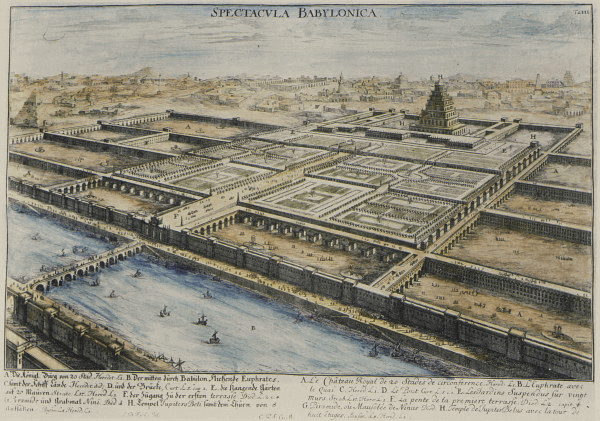
Babylon - Fischer von Erlach (1721)
The walls built by the massive slave army at Babylon circled an early nearly two hundred square miles and were all painted with a bright blue dye along with the inscription "I am Nebuchadnezzar, King of Babylon".
Ishtar Gate
In addition to the triple wall fortifications, Nebuchadnezzar constructed elaborate gates throughout the city. The most famous of which was a massive structure called the Ishtar Gate.

Ishtar Gate Drawing
The Ishtar Gate guarded the inner most sanctum of Babylon and is one of the best artifacts we currently have from the excavated city.

Ishtar Gate Relief
Hanging Gardens of Babylon
According to some, Nebuchadnezzar was the one who built the Hanging Gardens of Babylon for his homesick wife Amytis of Medes, while others attribute it to the Assyrians who rebuilt it under King Sennacherib.
The truth is, this many not be an either or question. The building and construction of massive gardens was a cultural tradition in this part of the world and was mostly used to display dominance over water, a precious natural resource in the normally hospitable desert.

Hanging Gardens of Babylon - 19th Century Engraving
The ancient Mesopotamians were avid water engineers, building aqueducts, reservoirs, canals and many other public works projects to expand their society. It is only natural they turned this into an art form and built lavish gardens to showcase their engineering prowess.
In fact, these gardens are were some Greek engineers may have gotten their ideas for water manipulation from. Learn more about the Hanging Gardens of Babylon here.
Military Conquests
Under Nebuchadnezzar, Babylon was able to consolidate and expand its power in the region. The first thing he did was turn on his fathers old allies, the Cimmerians and the Scythians and Nebuchadnezzar expanded towards the Median empire.
Through a political marriage to Amytis of the royal family of Medes, Nebuchadnezzar was able to bring about a political alliance between the two empires and ushered in a golden age for his civilization.
With the Medes secured on the west, Nebuchadnezzar now turned his eyes towards expanding Babylon into the Aramea occupied Syria known as Aram and eventually into the Kingdom of Judah.
Invasion of Egypt
In 601 BC, Nebuchadnezzar led an invasion of Egypt that was made much more difficult by internal conflict and strife between Babylon's states. During the attempted invasion, the Phoenician states all rebelled against Nebuchadnezzar and tried to get their independence.
Nebuchadnezzar was going to have nothing of that and he began to quash the rebellion. In 597 BC he laid siege to the city of Jerusalem and deposed of its King Jehoiakim. In 587 BC during the occupation of the city, there was a violent uprising and Nebuchadnezzar destroyed the city and deported many of the elite Jews along with a great majority off their population Babylon.
It was here that the Jews would write the Babylonian Talmud, a document full of vitrol for their oppressors. These events are specifically described in the Prophets (Nevi'im) and Writings (Ketuvim) along with sections of the Hebrew bible.
Next, Nebuchadnezzar turned his sights on the rebellious city of Tyre. After thirteen years Nebuchadnezzar was able to conquer the city and instead of continuing onto Egypt he returned to Babylon to engage in another round of massive public works projects.
End of Nebuchadnezzar
In his final days, Nebuchadnezzar began a massive project of building canals, aqueducts, temples, reservoirs and many other public works projects in the hope of a better Babylon. Following the brutal destruction of Babylon after the Assyrian rule, Nebuchadnezzar wanted to rebuild Babylon as a capital of the ancient world and home to many of its wonders.
According to Berossus and Abydenus in Eusebius, Praeparatio Evangelica, 9.41 he was thought to have also prophesied the end of his Chaldean dynasty much like Hammurabi of the Amorite Dynasty and the Assyrians before him. After forty two years of rule he died in Babylon and was succeeded by Amel-Marduk in 562 BC.
The Babylonian dynasties continued for many more years after the death of Nebuchadnezzar. Rule was eventually passed from Nabonidus to Belshazzar however, the empire became gradually weaker over time and this left it ripe for an invasion from the west.